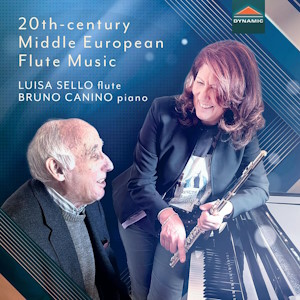
20th Century Middle European Flute Music
Ernst Heinrich Krenek (1900-1991)
Suite for flute and piano (1954)
Emil František Burian (1904-1959)
Ztracené serenády for flute and piano (1940)
Paul Dessau (1894-1979)
Guernica for piano (1938)
Arnold Schoenberg (1874-1951)
Sonate for flute and piano (1923-26, arr. Felix Greissle)
Luisa Sello (flute)
Bruno Canino (piano)
rec. 2023, Black Mirror Studios, Udine, Italy
Dynamic CDS7995 [61]
“Middle-European” loosely refers to countries west of Russia and east of France. Here we have an Austrian of Czech origin, a Czech, a German and an Austrian. Their personal histories are marked by persecution and emigration.
Ernst Krenek, born in Vienna on 23 August 1900, moved to the United States in 1938 to escape Nazi persecution. There he taught at several universities. Stylistically, he is hard to pin down: at one time or another, he adopted atonality, serialism, neo-classicism, jazz and electronics. His later music tended to be more accessible.
The Suite for flute and piano is in a neo-classical style, with a few atonal moments. It makes an attractive introduction to Krenek’s music. It has four movements, Andante, Allegretto moderato, Andante con moto and Allegro vivace (all on one track here). It was premiered in Santiago, Chile on 5 July 1956. Krenek later arranged it for flute and string orchestra.
Emil František Burian, born in Plzeň (Pilsen), was a bit of a polymath, actively involved in music, poetry, film-making and the theatre. He was also a journalist, a political activist in the Czech Communist Party and a parliamentarian. Burian was interned by the Germans between 1941 and 1945, but survived Theresienstadt, Dachau and Neuengamme.
Ztracené serenády (Lost Serenades) is an easy-going, charming piece, with no problems for the listener. It too has four movements, Cantabile, Na jednu (For one), Volně a zpěvně (Free and singing), Velmi zpěvně (Very singing). This recording is a world premiere.
Guernica is remembered as the site of one of the worst atrocities of the Spanish Civil War in 1936-1939. The German Condor Legion and the Italian Aviazione Legionaria blitzed this defenceless northern Spanish town in support of General Franco’s Nationalists. There were many deaths and injuries. Pablo Picasso was moved to paint his eponymous anti-war masterpiece in 1937.
Hamburg-born composer and conductor Paul Dessau was also persecuted by the Nazis. In 1933, he fled Germany first for Paris and then the United States. After the war, he moved to East Berlin. He wrote Guernica for piano solo in Paris, so he may have seen Picasso’s painting. The piece has all the hallmarks of twelve-tone music, but it is not overtly challenging. Dessau uses the technique with flexibility, so there are lyrical passages and harder-edged moments.
The major event on the disc is Felix Greissle’s transcription of Arnold Schoenberg’s Wind Quintet op.26, renamed Sonate inthis arrangement. Greissle, a student who lived at Schoenberg’s house, would eventually marry his eldest daughter, Trudi.
The Quintet is one of “the most abstract, most brittle” of Schoenberg’s compositions. At three-quarters of an hour, it is quite a trial. Historically, it is deemed to be a “classical work of the twelve-note-technique”. It is in four movements, Allegro, Scherzo, Adagio and Rondo. Despite serialism, there is a profound continuum between classical sonata form and modernism.
When Felix Greissle came to transcribe the Quintet, Schoenberg was adamant that no note of the original should be lost. Every note not played by the flute was to be included in the piano part. I have not seen the score, but it must be difficult for the pianist. One way or another, Greissle has managed to synthesise all five wind parts for the solo flute.
The opening movement presents themes, developments, recapitulations and even a coda. It may not seem obvious to the listener, though. Equally traditional, at least formally, is the quicksilver Scherzo. It may just be that it outstays its welcome. The heart of the Quintet is the Adagio, which is in ternary form. The concluding Rondo is the most congenial part of the work.
As part of my preparation for this review, I listened to the original Wind Quintet. Although it is difficult, I did begin to enjoy it. The Sonate version seems more approachable, and would serve as a worthy introduction for the stronger meat of the Quintet.
The duo of flautist Luisa Sello and pianist Bruno Canino give commanding performances, abetted by an excellent recording. Danilo Prefumo’s liner notes, in Italian and English, give a good outline of the music and its context. They are a little too long-winded on the definition of Middle-European: suffice to say the former Austro-Hungarian Empire and Germany are a good approximation.
This fascinating disc features four composers who are quite different in character but are united in their response to political extremism.
John France
Help us financially by purchasing from



















